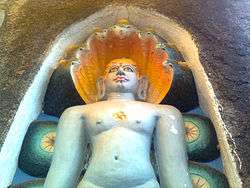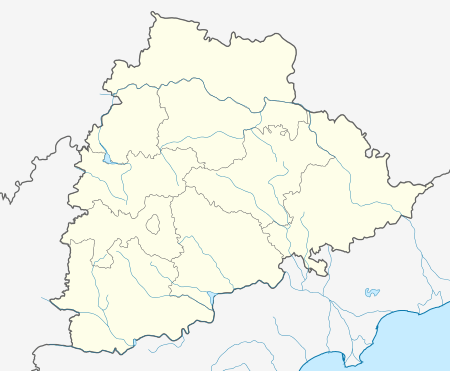Hanamkonda
| Hanamkonda Anmakonda | |
|---|---|
| Urban | |
 Jaina Tirthankara Relief at Padmakshi Temple | |
 Hanamkonda Location in Telangana, India  Hanamkonda Hanamkonda (India) | |
| Coordinates: 18°01′00″N 79°38′00″E / 18.0167°N 79.6333°ECoordinates: 18°01′00″N 79°38′00″E / 18.0167°N 79.6333°E | |
| Country |
|
| State | Telangana |
| District | Warangal (urban) |
| Founded | 1199 |
| Founded by | Ganapatideva |
| Government | |
| • Type | Municipal council |
| • Body | Greater Warangal Municipal Corporation |
| Languages | |
| • Official | Telugu |
| Time zone | UTC+5:30 (IST) |
| PIN | 506 xxx |
| Telephone code | +91–870 |
| Vehicle registration | TS–03 |
Hanamkonda is the major shopping and residential locality in Warangal City, Telangana, India.
It is also a Mandal in Warangal Urban District. it falls under Greater Warangal Municipal corporation.
Localities in Hanumakonda
- Hanamkonda
- Balasamudram
- Vidyaranyapuri (KU area)
- Kumarapally
- Palivelpula
- Bheemaram
- Yerragattugutta
- Hasanparthy
- Ramaram
- Lashkar Singaram
- Gopalpur
- Waddepally
History
We know the great kings of Kakatiya dynasty. Their marks have been left etched on the state of Telangana for over a several centuries. The famous fort of Warangal and the thousand pillared temple it has come to light that the original capital of Kakatiya Kings was not Warangal; they in fact had shifted the capital to Warangal for reasons unknown. It could probably be strategically ideal for a King to run his empire from the hill fort of Warangal.
Hanamkonda or Anmakonda is a short distance from the north of Warangal, and may be the ancient suburb of Warangal. Hanamkonda was the older capital of the Kakatiya kings before they actually shifted the new capital to Warangal during the reign of Ganapati Deva. The district around it was called Sabbi sayira or Sabbi one thousand which was a part of the empire of Kalyani. The land of Hanamkonda was also referred to as Anmakonda Vishaya. However, the actual Sanskrit name was supposed to be Hanumnadachala or the Hill of Hanumat (Hanuman), the famous follower of the hero of Ramayana, Lord Rama. The most breath-taking feature of Anmakonda is the hill is the thousand pillar temple built by King Rudra in 1163 CE.
Warangal eventually replaced Anmakonda as the new city during the time of Ganapati Deva. Warangal was actually the corrupted term or the later name for Orukkal, which means ‘one rock.’ In the Sanskrit texts the name sees a literal translation of Orukkal as Ekasaila, whose again original form was Ekasailanagara. The Telugu form of the name is Orumgallu. The city was prosperous needless to say.
In the time before Ganapati deva, the city of Warangal occupied a menial position but it was finally king Rudra I who further popularized the city by his work. It was provided with a stone wall by Rudra’s nephew and successor Ganapati. The fortifications of the city were finally completed by the daughter and successor Rudramma devi. From the onset of 14th century, the city had to face successive wars under the hands of Tugluq dynasty. Mohammed bin Tugluq took it in 1323 CE and again renamed the place as Sultanpur. Finally the city’s pride was lost upon the rising of Bahamani sultanate and shifting of capitals to Golconda in Hyderabad.
Climate
As Hanamkonda is located in the semi-arid region of Telangana, it has a hot and dry climate. Summer starts in March and continues through mid-June. The monsoon arrives in June and lasts until September. Winter starts in mid-October and lasts until early February.
| Climate data for Hanamkonda | |||||||||||||
|---|---|---|---|---|---|---|---|---|---|---|---|---|---|
| Month | Jan | Feb | Mar | Apr | May | Jun | Jul | Aug | Sep | Oct | Nov | Dec | Year |
| Record high °C (°F) | 35.8 (96.4) |
39.6 (103.3) |
42.2 (108) |
45.1 (113.2) |
47.2 (117) |
47.8 (118) |
39.6 (103.3) |
39.6 (103.3) |
38.4 (101.1) |
38.6 (101.5) |
35.1 (95.2) |
35.1 (95.2) |
47.8 (118) |
| Record low °C (°F) | 8.9 (48) |
10.6 (51.1) |
11.7 (53.1) |
17.8 (64) |
17.2 (63) |
16.3 (61.3) |
17.8 (64) |
16.6 (61.9) |
17.6 (63.7) |
15.0 (59) |
9.4 (48.9) |
8.3 (46.9) |
8.3 (46.9) |
| Average rainfall mm (inches) | 72 (2.83) |
82 (3.23) |
71.1 (2.799) |
83.6 (3.291) |
75.7 (2.98) |
197.6 (7.78) |
227.8 (8.969) |
190.5 (7.5) |
304.8 (12) |
136.4 (5.37) |
92.7 (3.65) |
42.4 (1.669) |
1,576.6 (62.068) |
| Source: India Meteorological Department (Record High, Record Low Temperatures: 1902–2009)[1] | |||||||||||||
Culture



Padmakshi Temple, believed to have been built during the first quarter of the 12th century, is a temple at Warangal with Goddess Padmakshi as the main deity. Thousand Pillar Temple was built during the period of the Kakatiya dynasty, and later destroyed by Muslim invaders. The temple called the Trikutalayam, dedicated to Shiva, Vishnu, and Surya. Bhadrakali Temple at Hanamkonda is a significant Goddess Bhadrakali temple located on the hilltop.
Education
Kakatiya University is an autonomous educational institution, approved under Universities Grant Commission scheme.[2]
Major universities and educational institutions of the area include, National Institute of Technology, Kakatiya University, University Arts and Science College, Kakatiya Institute of Technology and Science, SR Engineering college, Vaagdevi College of Engineering, Aurora Degree College, Kakatiya Medical College, Ramappa Engineering College and more.
Srinivasa Ramanjuan Concept School is a day and residential Central Board of Secondary Education school with over 700 students in Hanamkonda.
Transport
The public transport include, metro bus services operated by TSRTC under JNNURM.[3]
References
- ↑ "Ever recorded Maximum and minimum temperatures up to 2010" (PDF). India Meteorological Department.
- ↑ "Autonomous colleges list" (PDF). Universities Grants Commission. Retrieved 27 September 2016.
- ↑ "24 TSRTC buses inaugurated". The Hindu. 8 September 2016. Retrieved 15 October 2016.